 THE MINERAL CHRYSOCOLLA
THE MINERAL CHRYSOCOLLA
- Chemistry: CuSiO3 - nH2 O, Hydrated copper silicate
- Class: Silicates
- Subclass: Phyllosilicates
- Uses: minor ore of copper and an ornamental stone.
Specimens
Pure chrysocolla is soft and fragile and therefore not appropriate for use in jewelry. However, chrysocolla often is "agatized" in chalcedony quartz and it is the quartz that provides the stone with its polish and durability. Druzy Chrysocolla is a rock composed of agatized chysocolla with a crust of small sparkling quartz crystals in small cavities. A skilled craftsman, if able to polish a specimen that accentuates the colored swirles of chrysocolla and sparkles of the druzy quartz, can produce a lovely and valuable piece of jewelry. Occasionally, chrysocolla can have a turquoise color and be used as a fraudulent substitute for the more precious stone.
PHYSICAL CHARACTERISTICS:
- Color is a unique green-blue but can vary widely from more blue to more green, often in the same specimen.
- Luster is earthy to dull or vitreous and waxy.
- Transparency specimens are translucent to opaque.
- Crystal System is probably monoclinic or orthorhombic.
- Growth Habits include mostly massive forms that can be crusts, stalachtites and botryoidal. Also as inclusions in other minerals such as quartz.
- Cleavage is absent.
- Fracture is pronounced conchoidal.
- Hardness is variable from 2 to 4.
- Specific Gravity is approximately 2.0 - 2.3 (very light)
- Streak is white to blue-green.
- Associated Minerals are quartz, limonite, azurite, malachite, cuprite and other secondary copper minerals.
- Other Characteristics: may have an opal like appearance.
- Notable Occurrences include Arizona, Utah, New Mexico and Pennsylvania, USA; Isreal; Zaire and England.
- Best Field Indicators are lack of crystals, color, fracture, low density and softness.
 Amethyst Galleries' Mineral Gallery MINERALS |
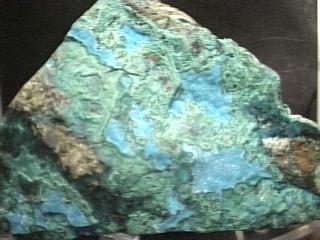
$ 450.00
Dims: 9" x 8" x 5"
Wt: 10 lbs., 4 oz
unknown
One of our largest and best pieces of Chrysocolla, this behemoth is beautifully colored with over 10 square inches of Drusy Chrysocolla surrounded by patches of massive Chrysocolla and maybe a little Malachite. The matrix rock is indeterminate, but has many veins of Chrysocolla running through it. The colors in this specimen range from a dark blue-green to a dark green-blue to a bright aqua-blue in the druses. This specimen is truly awesome in its size and beauty.
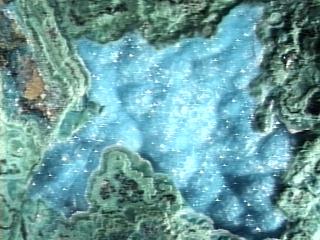

unknown
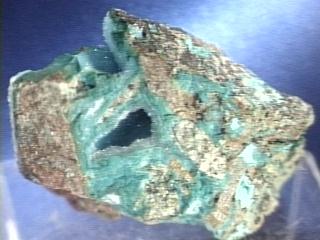
CHRYSOCOLLA specimen chc-3
$ 35.00
$ 35.00
Dims: 3" x 2-1/2" x 2"
Wt: 10.2 oz
unknown
This specimen is perfect for the collector that wants a piece of quality Drusy Chrysocolla at an affordable price. It has about one-fourth of its surface area covered with Chrysocolla, and two hollows filled with drusy, one of them surprisingly deep! It also seems to have an area with some decomposed material that is a very light green-blue and of a chalky consistency. I would consider this piece to be one of the better values for the customer's money.

chc-3 ($ 35.00)
unknown
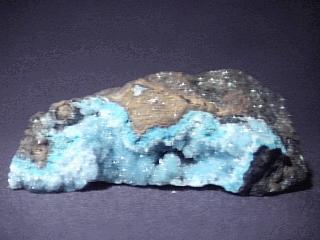
CHRYSOCOLLA specimen chc-9
$ 60.00
$ 60.00
Dims: 3.3" x 1.6" x 1.0"(8.4 x 4.1 x 2.5 cm)
Wt: 2.89 oz.(81.9 g)
Inca de Oro, Chile
A rather small hand specimen, this piece consists of a host rock, probably goethite, that is brown to black in color and shows a banded pattern and evidence of botryoidal formations. It is generally rough in appearance, has a dull luster, an is opaque. A largish depression spans most of its length; this depression is lined with a coating of Chrysocolla that is anywhere from 0.1 - 0.2"(2-4 mm) thick. It has the standard aqua-blue color and waxy luster where it is visible. Only the broken edges of this crust can be clearly seen, as it is entirely covered with a druse of tiny, transparent quartz crystals. These have the standard hexagonal prismatic form, vitreous luster of quartz, and are quite clear. They add a sparkle, that along with the Chrysocolla's color, makes an excellent contrast to the dull brown host rock.

chc-9 ($ 60.00)
Inca de Oro, Chile
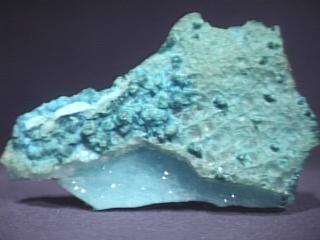
CHRYSOCOLLA specimen chc-10
$ 100.00
$ 100.00
Dims: 3.8" x 2.7" x 0.7" (9.7 x 6.9 x 1.8 cm)
Wt: 2.36 oz.(67.1g)
Yavapai County, Arizona, USA
A sparkly quartz druze lines a cavity between layers of chrysocolla - but the cavity is almost filled by the quartz. The bulk of this specimen is alternating layers of chrysocolla and malachite, each a milimeter or less thick. One side is mostly blue chrysocolla, and there are numerous round botryoidal formations of malachite. This piece comes from the 3100 foot level of the Giroux cut of the open pit Bagdad Copper Mine in west central Yavapai County , Arizona.
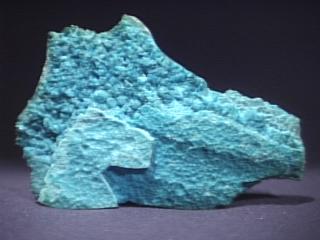

chc-10 ($100.00)
Yavapai County, Arizona, USA
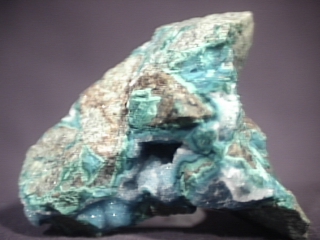
CHRYSOCOLLA specimen chc-15
$ 40.00
$ 40.00
Dims: 3.5" x 3.1" x 1.9" (8.9 x 7.9 x 4.8 cm)
Wt: 7.95 oz. (225.5 g)
unknown
Another specimen from an as-yet-undetermined locality, this piece consists of a slightly green quartzite host rock that appears to have been partially broken and then "glued" back together when massive Chrysocolla filled up the spaces between the pieces. The Chrysocolla has a wonderful, bright green-blue coloration and shows a small amount of layered banding. In spots where there was a rather large space between broken pieces of the quartzite, hollows formed inside the Chrysocolla. These hollows are lined with thin layers of fine, transparent quartz crystals, creating what is known as "drusy Chrysocolla". The hollows tend to give the Chrysocolla the space it needs to form slight botryoidal formations. There is only one hollow visible on the specimen, but exposed druses of the quartz show where other hollows were. The Chrysocolla has a pearly to waxy luster and is opaque.

chc-15 ($ 40.00)
unknown
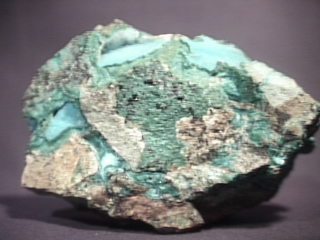
CHRYSOCOLLA specimen chc-16
$ 50.00
$ 50.00
Dims: 5.5" x 3.6" x 2.1" (14.0 x 9.1 x 5.3 cm)
Wt: 1 lb., 7.3 oz. (661 g)
unknown
One of our larger specimens of the "unknown" Chrysocolla, this piece consists of a quartzite base that has a substantial portion of its surface covered with a very thin layer of blue-green Chrysocolla. Though it exhibits no definite crystalline form, close examinations of this thin crust shows that it contains scores of tiny botryoidal nodules that extend partially out of it. It is waxy in luster, and is likely opaque. Patches of the crust are coated with thin druses of tiny, transparent quartz crystals. These areas have a much brighter, bluer color than the uncoated material, and the quartz gives them a bright sparkle that is very attractive.

chc-16 ($ 50.00)
unknown
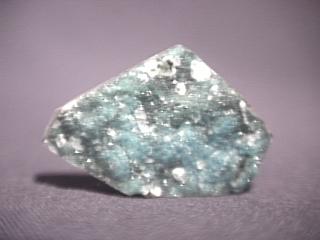
CHRYSOCOLLA specimen chc-17
$ 35.00
$ 35.00
Dims: 1.7" x 1.1" x 0.3" (4.3 x 2.8 x 0.7 cm)
Wt: 13.5 g
unknown
This very small specimen is not exactly what most collectors are looking for. However, it is perfect for the person that wants an attractive stone to set into a piece of jewelry! It consists of a flat piece of a greenish-brown quartzite host rock that has been cut and smoothed on 7 of its 8 sides. The last side has been left rough, as it is coated with a layer of Chrysocolla that is further coated with a thin druse of fine Quartz crystals, making drusy Chrysocolla. Its color ranges from a bright to a grayish aqua-blue, and it has a wonderful sparkle due to the tiny, transparent quartz crystals that cover it. Such a piece would make a lovely pendant, bracelet, or even a belt buckle!

chc-17 ($ 35.00)
unknown
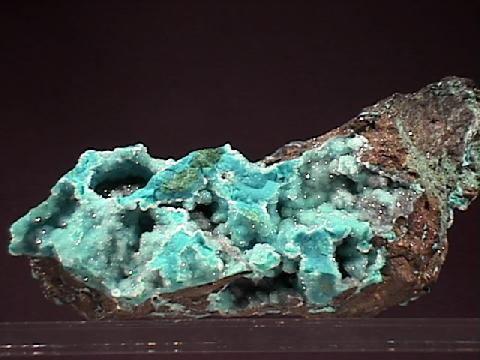
CHRYSOCOLLA specimen chc-18
$ 65.00
$ 65.00
Dims: 4.3 x 2.7 x 2.0" (10.9 x 6.9 x 5.1 cm)
Wt: 12.8 oz. (365.0 g)
Inca de Oro, Chile
This hand specimen consists of a rather odd formation of drusy Chrysocolla that rests on a dull, dark brown host rock. There is a considerable amount of damage to the formation, in that many breakage surfaces are visible. The material is generally massive and has only a mild reniform form, with a dull waxy luster. It has the deep aqua-blue coloration that one expects from this mineral, but there are a few noticeable green patches where the Chrysocolla enveloped smaller formations of massive malachite. Those surfaces that are not damaged are covered by a druse of tiny, heavily intergrown quartz crystals that are generally colorless and have a vitreous luster. There are several hollow depressions that extend into the Chrysocolla, giving it a rather odd shape, and a few veins of the mineral extend down into the brown host rock, which I think contains a considerable concentration of iron.
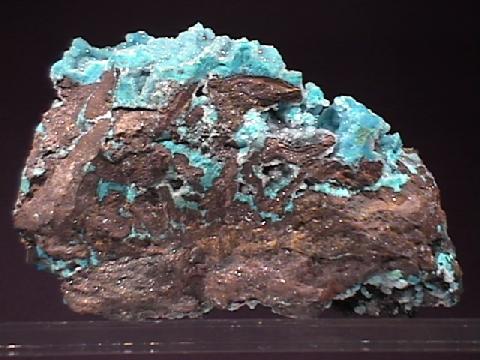

chc-18 ($ 65.00)
Inca de Oro, Chile
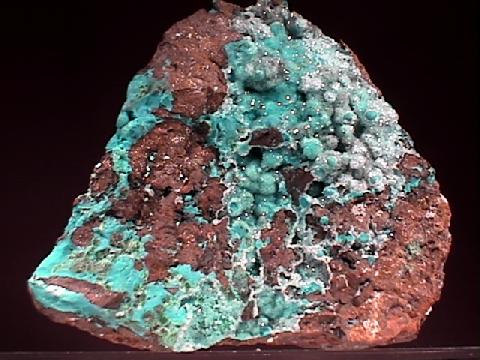
CHRYSOCOLLA specimen chc-19
$ 360.00
$ 360.00
Dims: 6.1 x 5.7 x 2.5" (15.5 x 14.5 x 6.4 cm)
Wt: 3 lbs., 14.6 oz. (1.774 kg)
Inca de Oro, Chile
This large hand specimen consists of a thin crust of massive and reniform Chrysocolla that coats a portion of a brown, iron-rich host rock. There is much damage to this crust in the form of breakage, showing the Chrysocolla's massive habit and uneven fracture. Some of the most severely damaged areas show patches of compact, radiating malachite that was covered by the crust, whereas those areas that are undamaged are coated with a druse of fine, colorless and transparent quartz crystals. A few small areas show where the druse was either broken or worn off, or did not form in the first place (see the close-up image). These undamaged areas reveal the reniform, nodular habit of the material, with some nodules exceeding 0.3" (8 mm) in diameter. All have the standard deep aqua-blue coloration and dull waxy luster. The base rock is likely made up of goethite or a related iron oxide, and contains hollows that are lined with tiny, intergrown reniform nodules.
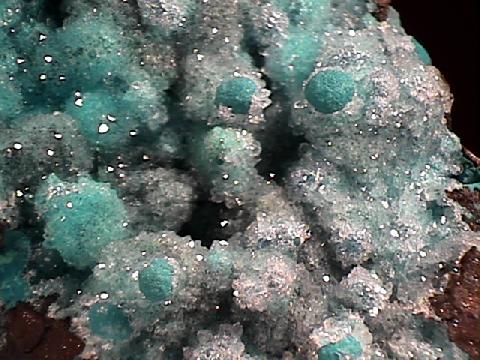

chc-19 ($360.00)
Inca de Oro, Chile
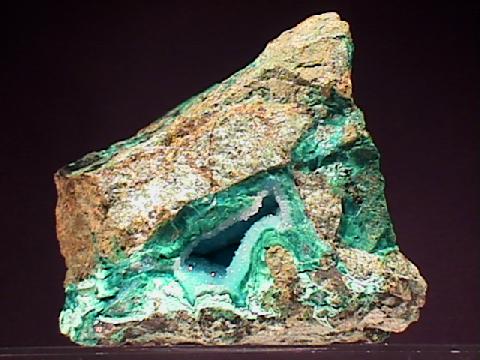
CHRYSOCOLLA specimen chc-20
$ 75.00
$ 75.00
Dims: 4.2 x 3.8 x 3.4" (10.7 x 9.7 x 8.6 cm)
Wt: 1 lb., 13.7 oz. (841 g)
unknown (likely Zaire)
Many thin layers of massive Chrysocolla extend through the rough brown host rock of this large hand specimen. These veins show some definite reniform tendencies, but they possess no definite crystal form. Being as such, the only damage that these veins show is where they are exposed on the specimen. All have beautiful pale-to-deep aqua-blue coloration and a dull waxy luster, though there are patches of material that have a dark green coloration which is likely due to the presence of malachite trapped in the veins. All are opaque, needless to say. There are hollows in the rock, at least 2 of which are visible, which are lined by the Chrysocolla and in turn covered with a druse of tiny quartz crystals. These crystals are in excellent condition and do not exceed 0.1" (3 mm) along any axis. They are colorless and transparent, and so appear to have the aqua-blue color of the chrysocolla.
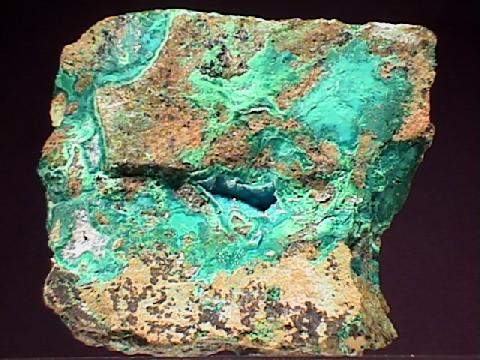

chc-20 ($ 75.00)
unknown (likely Zaire)
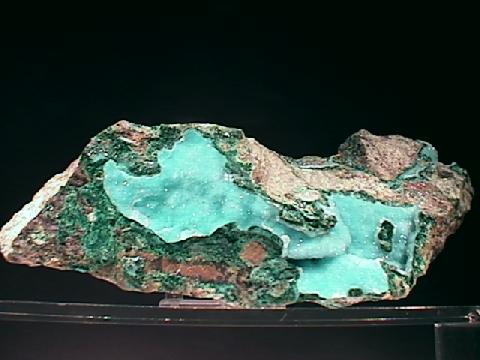
$ 300.00
Dims: 7.6 x 3.8 x 3.0" (19.3 x 9.7 x 7.6 cm)
Wt: 2 lbs., 2.5 oz. (978 g)
Zaire
This specimen consists of a brown host rock that is suffused with veins of massive Chrysocolla. Segveral of these veins contain hollows wherein lay druses of microscopic quartz crystals that coat the Chrysocolla. Many such druses are exposed and clearly visible on the piece, showing the bright aqua-blue color of the Chrysocolla and the sparkle of the quartz. The host rock has a pale brown coloration with faint hints of green in areas, and is likely made up of quartzite. A very small amount of malachite appears to be present, but most of the darker green coloration on the piece is likely due to the Chrysocolla.
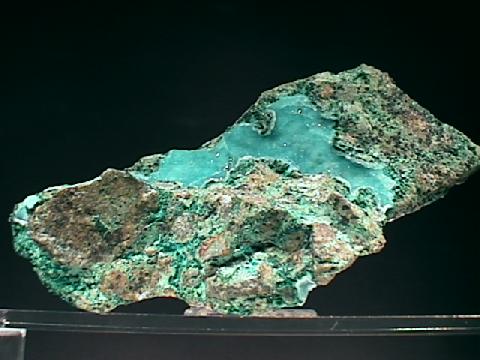

Zaire
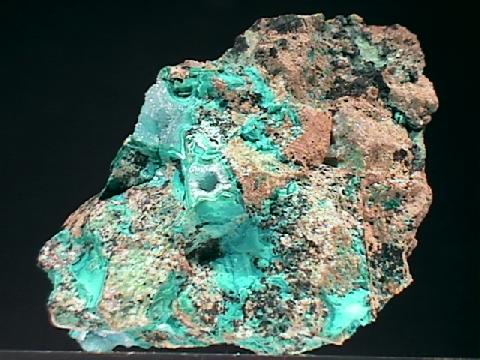
CHRYSOCOLLA specimen chc-22
$ 42.00
$ 42.00
Dims: 4.8 x 3.2 x 3.0" (12.2 x 8.1 x 7.6 cm)
Wt: 1 lb., 5.4 oz. (605 g)
Zaire
About half of the host rock of this hand specimen is heavily interspersed with veins of massive Chrysocolla. There are also a few hollows assoicated with these veins, whose surfaces are coated with druses of tiny, transparent quartz crystals. These crystals add a sparkle to the otherwise dull, resinous luster of the Chrysocolla. The aqua-blue mineral is easy to see against the brown color and earthy luster of the quartzite host rock.

chc-22 ($ 42.00)
Zaire
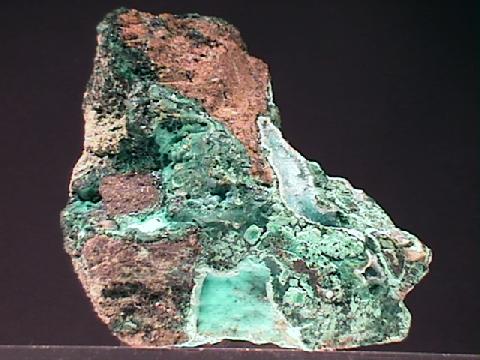
CHRYSOCOLLA specimen chc-23
$ 40.00
$ 40.00
Dims: 3.7 x 3.0 x 2.7" (9.4 x 7.6 x 6.9 cm)
Wt: 13.5 oz. (384 g)
Zaire
The brown quartzite host rock of this hand specimen is nearly half covered by thin crusts of massive and botryoidal Chrysocolla. The crust has a color that ranges from a moderately dark green to a pale aqua-blue and is mostly shapeless. It has a dull, resinous luster and is likely opaque or only dimly translucent at best. Portions of the crust are coated with either crusts of botryoidal or druses of crystalline quartz, all of which is colorless and transparent. It is difficult to determine whether or not there are any other copper-bearing minerals on the piece, given the range of colors that the Chrysocolla takes. The brown host rock has an earthy luster and contains only very thin veins of the mineral.

chc-23 ($ 40.00)
Zaire
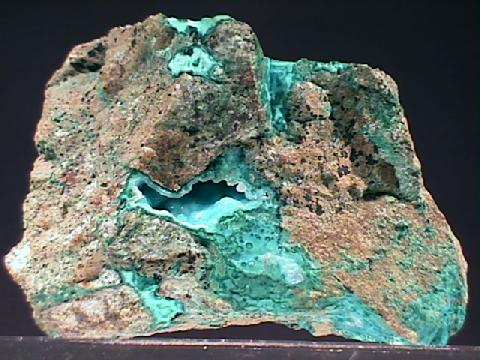
CHRYSOCOLLA specimen chc-24
$ 40.00
$ 40.00
Dims: 4.2 x 2.9 x 2.7" (10.7 x 7.4 x 6.9 cm)
Wt: 15.3 oz. (434 g)
Zaire
Several veins of massive and botryoidal Chrysocolla permeate the brown host rock of this hand specimen. This material generally does not show any appreciable crystal form, though a few hollows are present. It takes on undulating, botryoidal form in these hollows, and is usually crusted with a druse of tiny, transparent quartz crystals, whence it is then referred to as drusy Chrysocolla. Its color ranges from nearly green to a pale aqua-blue, and its luster is dull and resinous. It is only dimly translucent at best. I am not sure, but I think that the host rock is made primarily of a brown quartzite.

chc-24 ($ 40.00)
Zaire
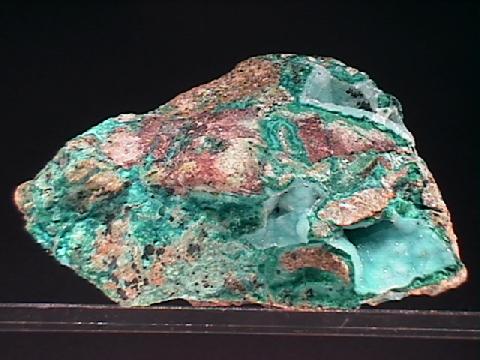
CHRYSOCOLLA specimen chc-25
$ 40.00
$ 40.00
Dims: 5.0 x 3.5 x 2.7" (12.7 x 8.9 x 6.9 cm)
Wt: 1 lb., 5.7 oz. (616 g)
Kolwezi, Zaire
Several veins of massive Chrysocolla extend through the pale brown host rock of this hand specimen. These veins do show some evidence of botryoidal form, but no discernable crystals are present. There are areas, however, where the veins met and hollows developed. A few of these hollows are visible and are lined with druses of tiny quartz crystals that give them a dull sparkle. The Chrysocolla has the classic blue-green-to-aqua-blue coloration and is essentially opaque.

chc-25 ($ 40.00)
Kolwezi, Zaire
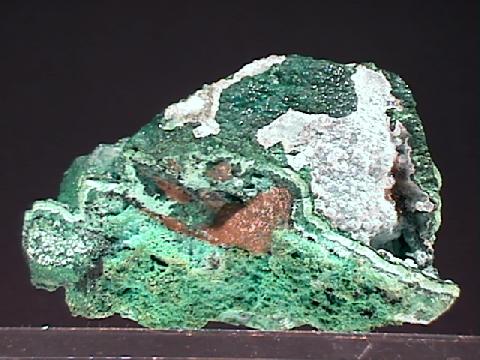
CHRYSOCOLLA specimen chc-26
$ 60.00
$ 60.00
Dims: 3.0 x 2.4 x 1.5" (7.6 x 6.1 d 3.8 cm)
Wt: 5.5 oz. (156 g)
Kolwezi, Zaire
This hand specimen is made up almost entirely of massive and botryoidal Chrysocolla. Its color ranges from a deep green with a slight blue tint to a bright aqua-blue to a nearly pure pale blue, and it has a luster that ranges from dull to waxy. Portions of one botryoidal crust are partly coated with a fine druse of tiny quartz crystals that borders on being a crust. There is only a small amount of a brown host rock present.

chc-26 ($ 60.00)
Kolwezi, Zaire
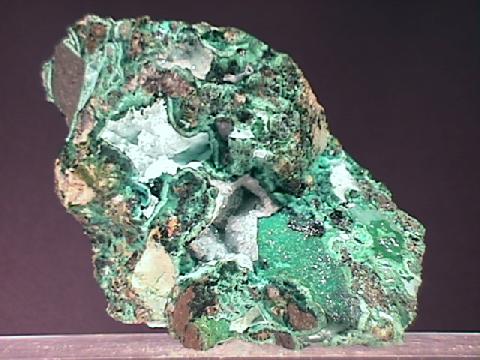
CHRYSOCOLLA specimen chc-27
$ 40.00
$ 40.00
Dims: 3.6 x 3.4 x 2.4" (9.0 x 8.5 x 6.1 cm)
Wt: 11.3 oz. (320 g)
Zaire
Many veins of micro-crystalline Chrysocolla permeate the brown host rock of this specimen. These veins are often layered and vary in color from pale, sky blue to a sea-green and in luster from matte to greasy. Portions are covered with thin druses of tiny, transparent quartz crystals, giving them the name of "drusy Chrysocolla".

chc-27 ($ 40.00)
Zaire
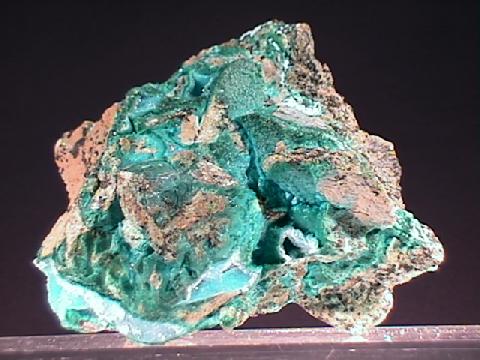
CHRYSOCOLLA specimen chc-28
$ 50.00
$ 50.00
Dims: 4.2 x 3.6 x 3.4" (10.7 x 9.1 x 8.6 cm)
Wt: 1 lb., 9.1 oz. (711 g)
Zaire
Several veins of massive Chrysocolla permeate the gray-brown host rock of this cabinet specimen. These veins show the classic deep aqua-blue coloration and waxy luster of the mineral, and several hollows that are crusted with thin druses of tiny quartz crystals. A few areas are coated with a very pale blue, chalky material that may be a decomposition product of the Chrysocolla. The host rock appears to be made out of quartzite.
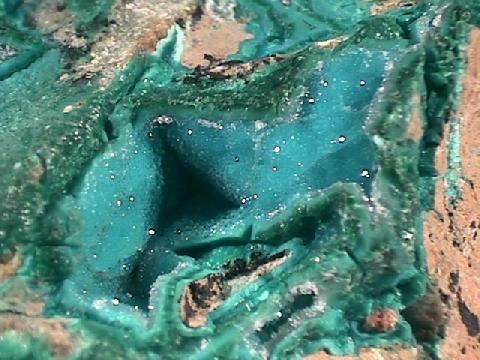

chc-28 ($ 50.00)
Zaire
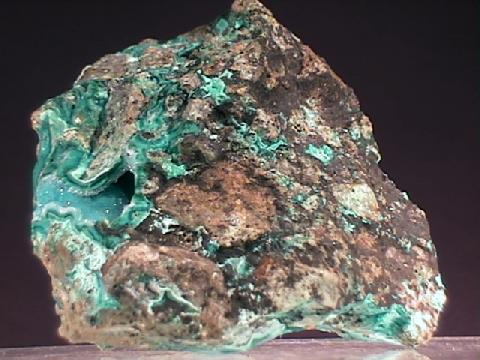
CHRYSOCOLLA specimen chc-29
$ 35.00
$ 35.00
Dims: 3.5 x 3.4 x 2.9" (8.9 x 8.6 x 7.4 cm)
Wt: 13.9 oz. (393 g)
Zaire
Several massive Chrysocolla veins extend through the quartzite host rock of this piece. The Chrysocolla has a varied aqua-blue coloration and shows definite layering and a waxy luster. At a few points it lines hollows in the quartzite host and is in turn coated with a druse of tiny, transparent quartz crystals.

chc-29 ($ 35.00)
Zaire
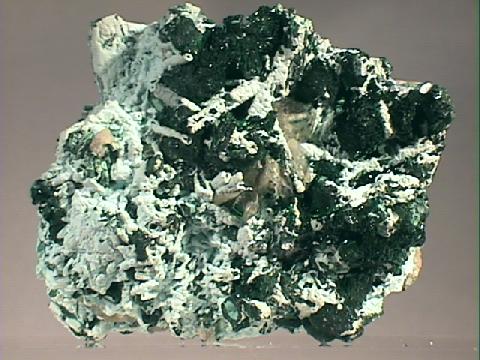
CHRYSOCOLLA specimen chc-30
$ 75.00
$ 75.00
Dims: 3.6 x 2.4 x 2.2" (9.1 x 6.1 x 5.6 cm)
Wt: 8.31 oz. (235.9 g)
Shaba Province, Zaire
A crust of powdery, massive Chrysocolla partly covers this specimen. It shows considerable damage in many areas and no crystal form except that which it has taken in the process of pseudomorphing from malachite. These forms are stalactitic in habit and generally consist of a layer of Chrysocolla that surrounds a thin "core" of malachite. The material has a very pale aqua-blue coloration and is completely dull in luster and powdery in consistency. The malachite that it coats occurs as clusters and sprays of tight, heavily intergrown and radiating needles that do not exceed 0.4" (1.0 cm) in length. A few dull yellow, transparent calcites are also present, and the host rock appears to be made up of layers of crystalline calcite and limestone.
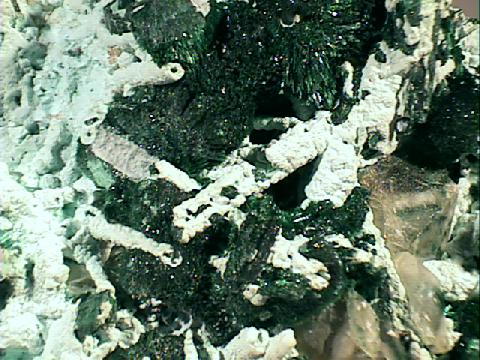

chc-30 ($ 75.00)
Shaba Province, Zaire
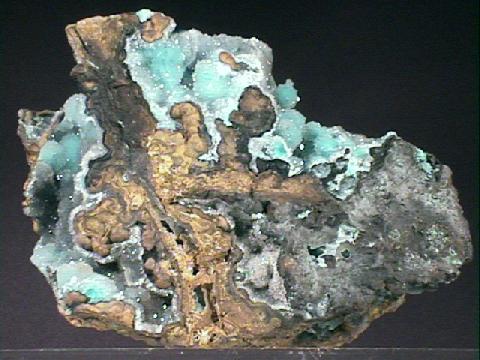
CHRYSOCOLLA specimen chc-31
$ 75.00
$ 75.00
Dims: 4.4 x 2.9 x 2.8" (11.2 x 7.4 x 7.1 cm)
Wt: 1 lb., 0.1 oz. (456 g)
Inca de Oro, Chile
This cabinet specimen consists of goethite base whose hollows are partly coated with quartz and Chrysocolla. The Chrysocolla has a massive, botryoidal habit and is essentially completely covered by the quartz- it is often called drusy Chrysocolla in this circumstance. It has the standard deep, aqua-blue coloration and dull, greasy luster of its specie, and is essentially opaque. Traces of malachite are also present, along with a probable decomposition product of it or azurite.
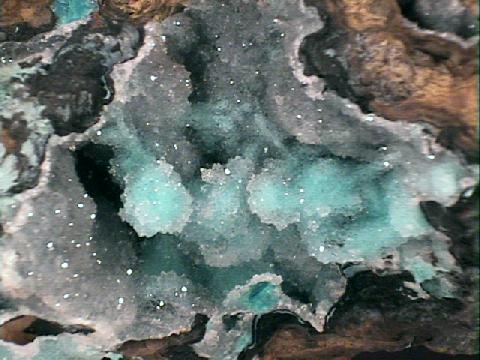

chc-31 ($ 75.00)
Inca de Oro, Chile
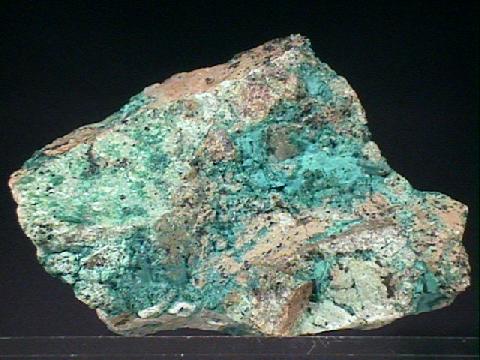
CHRYSOCOLLA specimen chc-32
$ 40.00
$ 40.00
Dims: 4.7 x 3.5 x 3.5" (12.0 x 8.9 x 8.8 cm)
Wt: 1 lb., 9.4 oz. (720 g)
likely Zaire
Many Chrysocolla veins extend through the gray siliceous base of this large cabinet specimen. The Chrysocolla is massive, showing no crystal form, and has the standard aqua-blue color and dull, waxy luster of its specie. Some of the veins open up into small hollows that are also lined with druses of tiny quartz crystals- a few such hollows are exposed, showing a much brighter aqua-blue color and a vitreous sparkle.
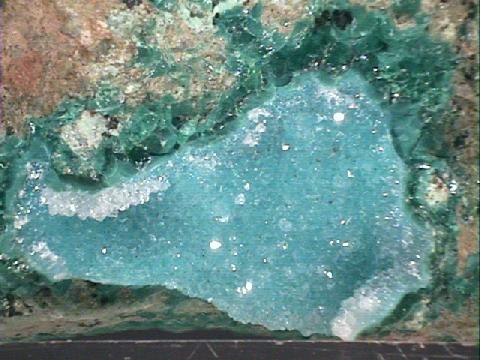

chc-32 ($ 40.00)
likely Zaire
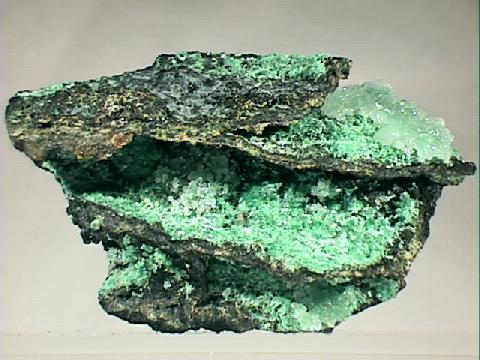
CHRYSOCOLLA specimen chc-33
$ 75.00
$ 75.00
Dims: 3.3x2.7x2.1" (8.4x6.8x2.1cm)
Wt: 13.4 oz. (378g)
Ray Mine, Pinal County, Arizona, U.S.A.
This is an interesting specimen. It is a combination of massive chrysocola and massive malachite, for the most part, but one cavity has a druze of clear quartz crystals over the chrysocola, plus a radial spray of acicular malachite crystals. On the back of the specimen, the green malachite, blue-green chrysocola, and transparent quartz form a collage of jumbled surfaces and cleavages, including some druzy malachite, and what appear to be crystals of chrysocola (visible with the aid of a loupe). There are also some boxy structures, laminar patterns, and platelets that make me think that these crystals formed over another mineral which since disolved away.

chc-33 ($ 75.00)
Ray Mine, Pinal County, Arizona, U.S.A.
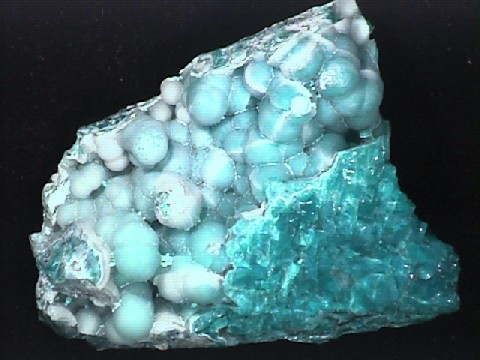
CHRYSOCOLLA specimen chc-34
$ 68.00
$ 68.00
Dims: 1.97x1.61x0.91" (5.0x4.1x2.3cm)
Wt: 1.8oz. (50.7g)
Ray Mine, Pinal County, Arizona, USA
This is a somewhat unusual specimen of chrysocolla. The bulk of the specimen is agatized chrysocolla, with an unusually deep blue color, and it is translucent to nearly transparent. A portion of this material was exposed in a cavity, and formed stalactites. These chrysocolla stalactites were covered with a thin layer of chalcedony with a small (and varying) amount of chrysocolla included, resulting in a rather pale blue color (in comparison), the color of turquoise. A few of the stalactites are broken (primarily along the edge of the specimen), revealing ½mm thick layer of chalcedony. There are no distinct quartz crystals, so there are no "sparkles", and this is not a "druzy" chrysocolla, but I do like it.
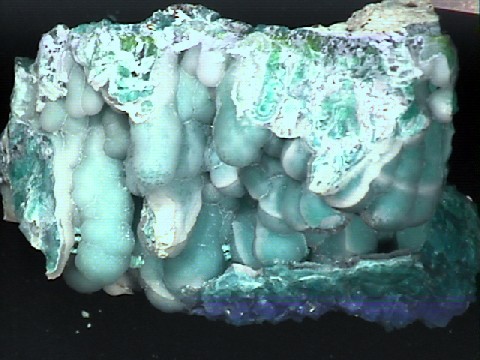

chc-34 ($ 68.00)
Ray Mine, Pinal County, Arizona, USA
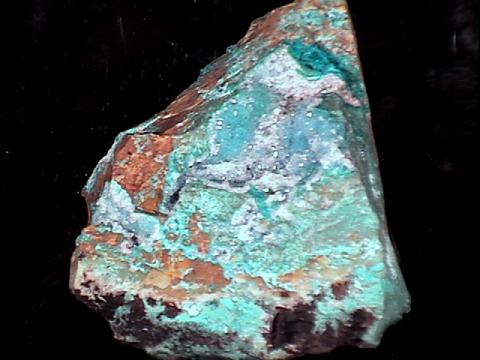
CHRYSOCOLLA specimen chc-36
$ 39.00
$ 39.00
Dims: 3.19x2.65x2.05" (8.09x6.73x5.20cm)
Wt: 10.42oz (294.8g)
Ray Mine, Pinal County, Arizona, USA
This large hand specimen of chrysocola is mostly light blue in color, with a few areas of translucent chrysocola crystals showing an intense blue color. In several protected cavities, the chrysocola sports a coating of clear quartz crystals, making this a "druzy chrysocola" specimen.
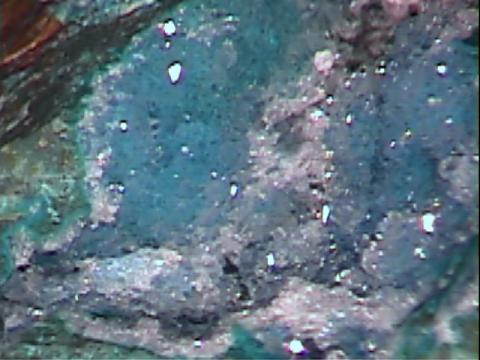

chc-36 ($ 39.00)
Ray Mine, Pinal County, Arizona, USA
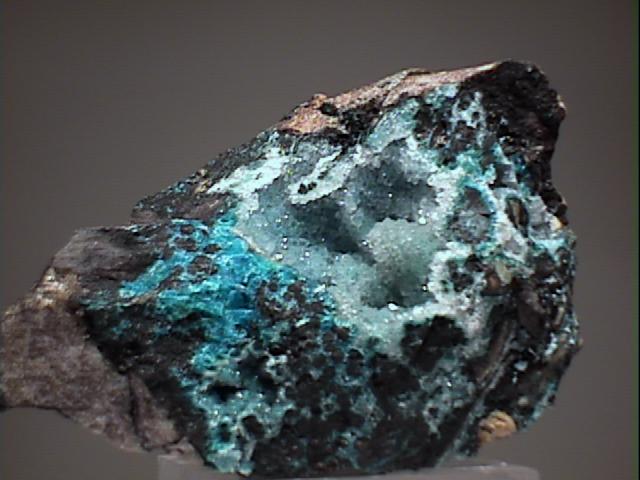
CHRYSOCOLLA specimen chc-35
$ 47.00
$ 47.00
Dims: 3.31x2.26x2.11" (8.40x5.75x5.35cm)
Wt: 8.27oz (234g)
Inspiration Mine, Gila County, Arizona, USA
This hand specimen displays some wonderfully deep blue nearly transparent crystals of chrysocolla (more properly, agate colored with chrysocolla), plus it has two areas where the agatized chrysocolla has been coated with a druze of quartz crystals, making this a "drusy chrysocolla" specimen. There is another area where the chrysocolla has a turquoise appearance, and some cavities in the agatized chrysocolla have a fine, powdery very pale blue coating, likely a weathering product of chrysocolla.

chc-35 ($ 47.00)
Inspiration Mine, Gila County, Arizona, USA
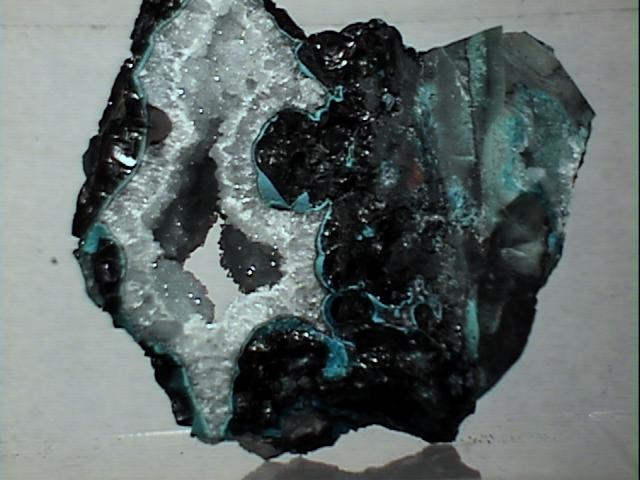
CHRYSOCOLLA specimen chc-37
$ 29.00
$ 29.00
Dims: 2.16x1.74x0.95" (5.48x4.43x2.40cm)
Wt: 2.95oz (83.6g)
Ray Mine, Pinal County, Arizona, USA
This is not a "druzy chrysocolla" specimen, but rather a "druzy quartz over chrysocolla" specimen. The quartz crystals are colorless but thick enough that the underlying layer of chrysocolla does not show through. The chrysocolla occurs in a thin shell lining the cavity under the quartz, and in several other areas totalling about 30% of the surface. Most of this is dull, opaque, and turquoise blue, but in a few areas the agatized chrysocolla is deep blue and translucent, with a vitreous luster. This is unusually pretty, and it is unfortunate that more of the exposed mineral does not have this form. Close examination with a loupe reveals that the thin layer between the quartz and the host rock is actually a radial growth of the deep translucent blue mineral with only a thin coating of the lighter, opaque mineral. That host rock looks like obsidian - it is black, vitreous, and exhibits a conchoidal fracture.
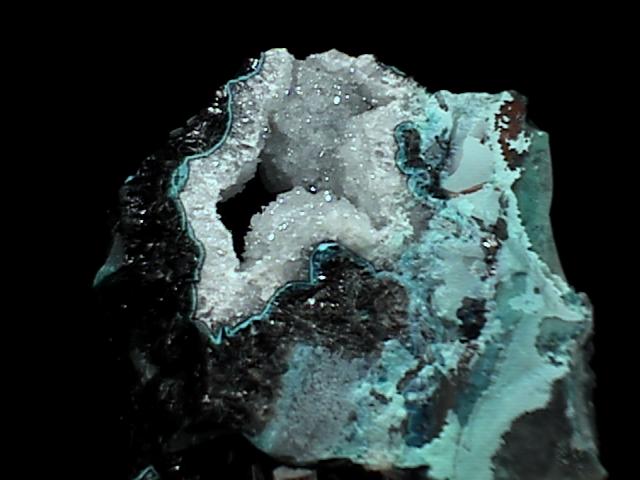

chc-37 ($ 29.00)
Ray Mine, Pinal County, Arizona, USA

CHRYSOCOLLA specimen chc-38
$ 165.00
$ 165.00
Dims: 2.08x1.27x0.94in (5.28x3.23x2.39cm)
Wt: 2.74oz (77.7g)
Shaba Province, Zaire
This stalactite is composed of chrysocola in rounded overlapping masses. It has a typical sky-blue color, although some patches are lighter in hue than others. The overall luster is dull, and while there are no crystals, my loupe reveals that the surface is composed of tiny bumps, each of which has a somewhat shiney appearance. There are several dark green patches of malachite; under the loupe, these resolve into a druze of very tiny transparent green crystals, still too small to reveal their form.


chc-38 ($165.00)
Shaba Province, Zaire

CHRYSOCOLLA specimen chc-41
$ 25.00
$ 25.00
dims mm=67.11x40.58x23.82
wt g=64.8
Congo
This specimen displays a lot of chrysocolla in the form of rounded balls of pure powder blue. Some of them have a layer of malachite crystals, and I suspect that the well-formed botryoidal masses of malachite conceal more chrysocolla.


chc-41 ($ 25.00)
Congo